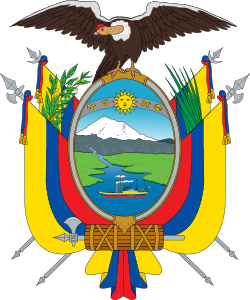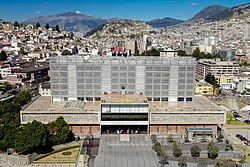| President | Períod |
|---|
| José Fernández Salvador López | 1830–1834 |
| José María de Arteta y Calisto | 1835 |
| Joaquín Gutiérrez Restrepo | 1836 |
| Fidel Quijano Valencia | 1837 |
| Víctor Félix de Sanmiguel Cacho | 1838 |
| José María de Arteta y Calisto | 1839–1840 |
| Joaquín Gutiérrez Restrepo | 1841 |
| Víctor Félix de Sanmiguel Cacho | 1842 |
| José María de Arteta y Calisto | 1843 |
| Joaquín Gutiérrez Restrepo | 1844 |
| Luis De Saá | 1845 |
| Víctor Félix de Sanmiguel Cacho | 1846–1847 |
| Salvador Ortega Estacio | 1848 |
| Pedro José de Arteta y Calisto | 1849 |
| Miguel Alvarado | 1850 |
| Pedro José de Arteta y Calisto | 1851 |
| Pablo Vásconez Román | 1852 |
| Antonio Bustamante del Mazo | 1853 |
| Miguel Alvarado | 1854 |
| Ramón Borja | 1855 |
| Carlos Tamayo | 1856 |
| Antonio Bustamante del Mazo | 1857 |
| Nicolás Espinosa | 1858 |
| Manuel Carrión | 1859 |
| Ramón Miño | 1860 |
| Pedro José de Arteta y Calisto | 1861 |
| Ramón Miño | 1862 |
| Antonio Gómez de la Torre | 1863 |
| Carlos Tamayo | 1864 |
| Pedro José de Arteta y Calisto | 1865 |
| Ramón Miño | 1866 |
| Antonio Muñoz | 1867 |
| Luis A. Salazar | 1868 |
| Manuel Checa | 1869 |
| Pablo Herrera González | 1869 |
| Ramón Miño | 1870 |
| Nicolás Martínez | 1871 |
| Rafael Carvajal Guzmán | 1872 |
| Luis A. Salazar | 1873 |
| Rafael Quevedo | 1874 |
| Pablo Herrera González | 1875 |
| Pedro Fermín Cevallos | 1876 |
| Julio Castro | 1877 |
| Antonio Muñoz | 1878 |
| Antonio Portilla | 1879 |
| Francisco A. Arboleda | 1880 |
| Vicente Nieto | 1881 |
| León Espinosa de los Monteros | 1882 |
| Vicente Nieto | 1883–1885 |
| Pedro Fermín Cevallos | 1886 |
| Pedro J. Cevallos y Fernández Salvador | 1886 |
| Alejandro Ribadeneira Salazar | 1887 |
| Julio Castro | 1888 |
| Antonio Robalino | 1889 |
| Luis A. Salazar | 1890 |
| Julio Castro | 1891 |
| Antonio Portilla | 1892 |
| José Modesto Espinosa | 1893 |
| Vicente Nieto | 1894 |
| José Modesto Espinosa | 1895 |
| Francisco J. Montalvo | 1896 |
| León Espinosa de los Monteros | 1897 |
| Vicente Nieto | 1898 |
| Manuel Montalvo | 1899 |
| José María Borja | 1900 |
| Belisario Albán Mestanza | 1901 |
| Leopoldo Pino | 1902 |
| Manuel Benigno Cueva Betancourt | 1903 |
| Belisario Albán Mestanza | 1904 |
| Leopoldo Pino | 1905 |
| Belisario Albán Mestanza | 1906 |
| Manuel Montalvo | 1907 |
| Pacífico Villagómez | 1908 |
| Alejandro Cárdenas | 1909 |
| Belisario Albán Mestanza | 1910 |
| Pacífico Villagómez | 1911 |
| Belisario Albán Mestanza | 1912 |
| Alejandro Cárdenas | 1913 |
| Francisco Andrade Marín | 1914 |
| Leopoldo Pino | 1915 |
| Manuel Eduardo Escudero | 1916 |
| Alejandro Cárdenas | 1917 |
| Leopoldo Pino | 1918 |
| Alejandro Cárdenas | 1919 |
| Belisario Albán Mestanza | 1920 |
| Leopoldo Pino | 1921 |
| Modesto A. Peñaherrera | 1922 |
| José María Ayora Cueva | 1923 |
| Manuel Eduardo Escudero Viteri | 1924 |
| Leopoldo Pino | 1925 |
| José Luis Román | 1925 |
| Modesto A. Peñaherrera | 1926 |
| José María Ayora Cueva | 1927 |
| Manuel Eduardo Escudero Viteri | 1928 |
| Manuel R. Balarezo | 1929 |
| Francisco Pérez Borja | 1930 |
| Pablo N. Roldán | 1931 |
| Manuel Eduardo Escudero Viteri | 1932 |
| Manuel María Borrero González | 1932 |
| José Antonio Baquero de la Calle | 1933 |
| Camilo Octavio Andrade López | 1934 |
| Vicente Enríquez Andrade | 1935 |
| Alejandro Ribadeneira Salazar | 1936 |
| Camilo Octavio Andrade López | 1937 |
| Benjamín Terán Coronel | 1939 |
| Camilo Octavio Andrade López | 1940 |
| Belisario Ponce Borja | 1941 |
| Celio Enrique Salvador Quintana | 1942 |
| Leoncio Patiño Carrión | 1943 |
| Aurelio A. Bayas Argudo | 1944 |
| Belisario Ponce Borja | 1945 |
| José María Suárez M. | 1946 |
| Belisario Ponce Borja | 1947 |
| Alejandro Ribadeneira Salazar | 1948 |
| Camilo Gallegos Toledo | 1949 |
| José María Villagómez Román | 1950 |
| Benjamín Cevallos Arízaga | 1951 |
| Luis F. Madera Negrete | 1952 |
| Manuel Elicio Flor Torres | 1953 |
| Alfonso Mora Bowen | 1954 |
| Camilo Gallegos Toledo | 1955 |
| José María Villagómez Román | 1956 |
| Benjamín Cevallos Arízaga | 1957 |
| Luis Eladio Benítez Jara | 1958 |
| Manuel Elicio Flor Torres | 1959 |
| Benjamín Cevallos Arízaga | 1960 |
| Camilo Gallegos Toledo | 1961 |
| José María Villagómez Román | 1962 |
| Francisco Montero Carrión | 1963 |
| Francisco Ochoa Ortiz | 1964 |
| Julio Tobar Donoso | 1965 |
| Francisco Páez Romero | 1965 |
| Arturo del Pozo Saltos | 1966 |
| Francisco Ochoa Ortiz | 1967 |
| Julio Tobar Donoso | 1968 |
| Benjamín Cevallos Arízaga | 1968 |
| Ricardo Cornejo Rosales | 1969 |
| César Durango Montenegro | 1970 |
| Rafael Terán Varea | 1971 |
| Miguel Aguirre Sánchez | 1972 |
| Tomás Valdiviezo Alba | 1973 |
| Carlos A. Jaramillo Andrade | 1974–1975 |
| Luis Jaramillo Pérez | 1976 |
| César Durango Montenegro | 1977 |
| Gonzalo Karolys Martínez | 1978–1979 |
| Armando Pareja Andrade | 1979–1981 |
| Gonzalo Zambrano Palacios | 1981–1983 |
| Carlos Pozo Montesdeoca | 1983–1984 |
| Gonzalo Córdova Galarza | 1984–1986 |
| Germán Carrión Arciniegas | 1986–1987 |
| Juan Agustín Quinde Burneo | 1987–1988 |
| Ramiro Larrea Santos | 1988–1990 |
| Walter Guerrero Vivanco | 1990–1993 |
| Francisco Acosta Yépez | 1993–1995 |
| Miguel Macías Hurtado | 1995 |
| Carlos Solórzano Constantine | 1995–1997 |
| Héctor Romero Parducci | 1997–2000 |
| Galo Pico Mantilla | 2000–2002 |
| Armando Bermeo Castillo | 2002–2004 |
| Hugo Quintana Coello | 2004 |
| Ramón Rodríguez Noboa | 2004–2005 |
| Guillermo Castro Dáger | 2005 |
| Jaime Velasco Dávila | 2005–2008 |
| Roberto Gómez Mera | 2008 |





